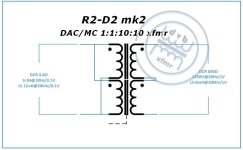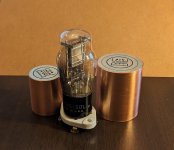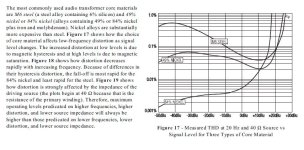I think that he using VAC toroidal cores...🙂 @bisesik makes excellent ones.
I saw very simmilar in Nagra factory tour video in part on transfromers winding...
https://www.vacuumschmelze.com/prod...and-cores/amorphous-and-nanocrystalline-cores
these brownish circular shape are good one.
But there are without the gap so no-magnetization current.
(They are high permeability, but relative permeability should be tested and calculated with 2-3 different amounts of turns...)
...
His trafos have very low Rdc of wire in prim and sec...
Last edited:
There are excellent and affordable 1:10 high nickel core microphone transformers out there
Can you recommend some? I'd like to give it a whirl.
In Serbia? A bit of a challenge I think.Can you recommend some? I'd like to give it a whirl.
I'd normally recommend Cinemag CMMI-10B or Jensen JT-115K-E.
When used with a 15...33R I/U resistor and offset current compensation distortion should at least approach 16 Bit equivalent at 20Hz.
At 77.5mV input via 150 Ohm source we get ~ 0.05% THD. If we drop source impedance, 75 ohm about halve THD.
So with 42R source from 20R DCR and 22R I/U conversion we should drop from 0.05% 20Hz THD to 0.012% @ 20Hz.
As our level also drops to ~ 30mV instead of -20dBu, likely we end up with a 20Hz THD in the ballpark of 0.006% or - 84dB. As frequency rises THD drops rapidly.
Secondary side would be ~ 300mV at 0dBFS, so we need a gain of ~ 6.66.
I think an E188CC or ECC88 with CCS load and set up for ZF should come close enough on HD, though sub 0.005% @ 2V out, even with feedback becomes challenging.
The next question is if we have need of this level of performance. And if we are really better off than just using a handful of transistors and a single high quality coupling capacitor.
Thor
You can mount Yourself a pretty good one with these Bownish VAC. (harder to mount beciuse iti is colosed toroid, but fewer turns because of huge permean+bility, very low DC resistance wire...Can you recommend some? I'd like to give it a whirl.
Or obtain some Permaloy EI laminations, also high premabile, more as vintage types slight more turns but easier to mount.
ebay
In my view mumetal/permalloy (50-80% nickel) covers 95% of the use cases for small signal, exactly how suitable HiB/GOSS cores are for output SE/PP stages in tube amplification.
More than 10 years ago I built a SUT xfmr for MC cartridges (R2D2-1:1:22:22) using nickel 80%, since then I've tried about any other type of core with no better results, same goes for HiB in output xfmrs (sure, after a detailed PROS and CONS assessment)
@Brijac - If you're looking for directions have a look on my page here, I make custom too (only if I like the project 🙂 );
https://www.facebook.com/profile.php?id=100057288107123
There's a highly sophisticated "1:10" xfmr 🙂
More than 10 years ago I built a SUT xfmr for MC cartridges (R2D2-1:1:22:22) using nickel 80%, since then I've tried about any other type of core with no better results, same goes for HiB in output xfmrs (sure, after a detailed PROS and CONS assessment)
@Brijac - If you're looking for directions have a look on my page here, I make custom too (only if I like the project 🙂 );
https://www.facebook.com/profile.php?id=100057288107123
There's a highly sophisticated "1:10" xfmr 🙂
Attachments
Last edited:
What I was thinking is to add such mode to my USB<->I2S project, it is not going to be hard to do. I already have mode for NOS DAC (or PCM mode) output, I just need to add special case for 16BCLK/Sample instead of 32. And then it would allow direct connection to TDA1541.
Can you add a SPDIF input?
You are using XMOS or something else? I have a LOT of experience with XMOS including using XU200 as a "hub" style chip including the ability to have SPDIF & I2S inputs with a low jitter adaptive clock.
You can PM me.
Thor
Impressive stuff.
Thor
In my view mumetal/permalloy (50-80% nickel) covers 95% of the use cases for small signal
It is important to remember that permalloy was empirically developed for audio (and near audio) band performance with low distortion for signals, be that electromechanical transmission of the hypnotism in the speech pattern of the Fuehrer and Senior Nazis (mid 1930's Germany) or the precise echolocation of German U-Boots under water (ASDIC UK 1930's). All of these were found to require low distortion transformers (among many other challenges).
Non of the modern cores and core materials have that explicit application profile. They are all designed for power electronics.
Can modern cores be pressed into audio use? Sure. You will have to do a lot of homework and the more exotic versions that suite audio are eye wateringly expensive and unsuited for traditional audio transformer winding machines. So there is extra investment before they can be used. Who pays for that?
Are they superior to traditional "designed for audio performance" materials?
I fear necessity (as there is less 80% Nickel Permalloy processes each year worldwide) in order to stay in the transformer making business are here "The Mothers of Invention":
If AM/NC cores were really superior to 80% nickel, their purveyors for sure would produce for sure detailed datasheets to demonstrate the superiority of their wares over "obsolete permalloy".
But I can find many detailed datasheets for permalloy cored transformers with distortion data, while all the AM/NC offerings are sold with datasheets I would not even describe as vestigial and which are heavy promotional superlative language and have zip useful data.
Now we have two options here.
Option one, the manufacturers lack the ability to perform detailed audio tests, which raises the question how they know their product is superior.
Option two, the performance is inferior (as I have repeatedly observed) but absent other ways of making transformers and with the investment into new specialised winding machines for ring cores, they have to be sold anyway. So no data is shown, as you never want to kill a good story with an inconvenient truth.
Then we are back at the point where we ask: "And what benefit do we get over a handful of BJT's?"
Now, we may have specific design goals in terms of sound quality that demand we use transformers, tubes, whatever. Then so be it.
Usually we do not want in this case the transformers and tubes for their outstanding objective performance, but despite their lacklustre objective performance. And then there is no point to pretend that we are implementing technically, objectively (according to some limited metrics) superior solutions that beat "normal cookie cutter datasheet solutions".
Thor
The CPLD is available at LCSC and current, so could go onto a PCB made by JLCPCB at a cost.
LCMXO2-256HC-4SG
If the coder remains on DIYA (which I believe he is) we could fix any bug.
So, jitter numbers for that FPGA suggest relocking is needed.
I suspect 256 LUT gives less than 256 Flip Flop equivalent, so the FPGA is too small for a meaningful FIFO buffer.
AK4118 seems annoying to implement in HW mode. CS8416 is old enough to shave. WM8805 is EOL. Annoying.
Maybe just butcher a WIIM ULTRA and use their entire frontend and just tap off IIS. But is that still DIY?
Thor
If AM/NC cores were really superior to 80% nickel, their purveyors for sure would produce for sure detailed datasheets to demonstrate the superiority of their wares over "obsolete permalloy".
Exactly!... I'll be more direct, if someone knows how to read between lines in the scarce literature then AM/NC has order of magnitude higher THD in some cases... as Bill Whitlock mentioned decades ago in "Handbook for sound engineers" the specs of permalloy are still untouchable for exotic "modern" dust 🙂
Attachments
Last edited:
Wuei seems to make excellent SPIDF input boards too.So, jitter numbers for that FPGA suggest relocking is needed.
I suspect 256 LUT gives less than 256 Flip Flop equivalent, so the FPGA is too small for a meaningful FIFO buffer.
AK4118 seems annoying to implement in HW mode. CS8416 is old enough to shave. WM8805 is EOL. Annoying.
Maybe just butcher a WIIM ULTRA and use their entire frontend and just tap off IIS. But is that still DIY?
Thor
Wiim doesn't solve the sim mode option.
HDMI option needs LVDS and is a pain on the receiver board side (or needs an extra recieveer board close to the core board.
IME, Spidf is better with copper than ligth fiber; and better with matched impedance pro plug than the generics RCA : you literally can hear the difference.
Then the USB B format is going to disseaper at the profit of USB C and HDMI (think TV). I had a philips TV with RCA spidf... it was better than my LG HDMI/Toslink. (ANyway they literally design those TV to last few years now whatever the brand).
https://www.diyaudio.com/community/threads/hdmi-to-i2s.418172/post-7802707 : it pop ups on Alibaba X press.
HDMi is going to winn the race , close followed by Bluetooth, ten we will have all air balls in apple shape in the ears, with the DAC beneath the skin connected to the watch by signals travelling into the fascias.... OK, I return to my Asimov book before to swapon Philips K Dick protocol ! Van Vogt knewabout the non Q flip flop world !
https://www.diyaudio.com/community/threads/hdmi-to-i2s.418172/post-7802707 : it pop ups on Alibaba X press.
HDMi is going to winn the race , close followed by Bluetooth, ten we will have all air balls in apple shape in the ears, with the DAC beneath the skin connected to the watch by signals travelling into the fascias.... OK, I return to my Asimov book before to swapon Philips K Dick protocol ! Van Vogt knewabout the non Q flip flop world !
Last edited:
Yes Long time ago He send me one (a pair input - revcover - output). I need more than one output for dual mono seprate SPDIF inpputs TDA1540. I mount Wuei SPDIF on shigaraki clone transport.Wuei seems to make excellent SPIDF input boards too.
It waa realy good.
I just have to modify the outputs, to match +-0.25Vp-p with Pi network. Was better sounding...
On the board was MCK of 33.xx MHz, some CPLD input and output was with HF transformers. I measured after the mod
the signal shape was excellent. I didnt have equipment to measure time-jitter...
I can recommend that SPDIF unit and I can send sch for upgradind outputs...
It is hard to find... 🙁permalloy are still untouchable for exotic "modern" dust
I remeber times before 30 years when pepole literary trowed away new and unpacked boxes of WAC small laminations
one cardboard "brick" pack probably was 15-20cm long
Welcome in 21st century 😉Exactly!... I'll be more direct, if someone knows how to read between lines in the scarce literature then AM/NC has order of magnitude higher THD in some cases... as Bill Whitlock mentioned decades ago in "Handbook for sound engineers" the specs of permalloy are still untouchable for exotic "modern" dust 🙂
Scarce literature?
Seconds of googling yield loads of scientific papers on amorphous and nanocrystalline core materials and their behavior in relation to older soft materials like permalloy.
Just an example:https://www.sciencedirect.com/science/article/abs/pii/S0304885316301561
A graphic (Finemet is Hitachi brand name for nanocrystalline):
Somewhat related to the current discussion
https://vintageking.com/shadow-hills-industries-mastering-compressorThe Mastering Compressor features Shadow Hills' custom transformer switching network with three output transformers options. These selections allow you to choose between different output transformers that are in effect: clean, colored, and dirty. The first position is Nickel which is a custom version of a famous LA custom console. This setting provides a natural-sounding low end and enhanced high frequencies. With the Iron section, the signal goes through the op-amp and into a Class A output stage (which only passes even-ordered harmonics) then through a custom Iron transformer for a slight boost at 110 Hz. The last transformer position is Steel which features an open and detailed sound with a boost at approximately 40 Hz for big low end.
Well I am just interested by USB, but as the board is I2S input I don't se the problem also of a Spidf input board with SMA/UFL output. Uf-L perhaps having a sligth edge in hassle because fragile, tinny but less prone to vibration transmission from the external cables of the sources if a MCLK was embeded on a core TDA1541A board.....
As far I am concerned te way I see it and designed my pcb is to have the choice about the active FDEm feeding, so both I2S & SI is possible as well as external Bck and Mclk signals...
But seems better when feeded by a well developped MclK or it will sounds maybe as an hold SPID reciever ! I have mixed thoughts but I am open; Me just needs USB, others I dunno; think Thorsten has many spidf sources too like TV, transports, etc.
As far I am concerned te way I see it and designed my pcb is to have the choice about the active FDEm feeding, so both I2S & SI is possible as well as external Bck and Mclk signals...
But seems better when feeded by a well developped MclK or it will sounds maybe as an hold SPID reciever ! I have mixed thoughts but I am open; Me just needs USB, others I dunno; think Thorsten has many spidf sources too like TV, transports, etc.
I see what they are doing in this very expensive compressor. I did it by chance, when I cap-coupled a passive DAC output to a step up transformer. It resulted in a boost at 30-40 Hz that sounded great with bookshelf speakers.
Welcome in 21st century 😉
Scarce literature?
Seconds of googling yield loads of scientific papers on amorphous and nanocrystalline core materials and their behavior in relation to older soft materials like permalloy.
While you're trying to look down on me with a shiny graphic (which is not literature, neither depicts THD) you're shooting yourself in the foot but I'm glad you posted it because it validates my opinion on permalloy and GOSS and maybe you'll learn something today for conveying this glorious commercial ad for FINEMET... but only if you take 2-3 steps back and analyze the big picture, yes? As such, permalloy is exactly where it should be for small signals PLUS the lowest THD in the bunch! Further more, HiB/GOSS has the highest tolerance for saturation, which is critical in high voltage swing over the lower band frequencies.
In other words, to welcome me properly in the 21st century, your graph should contain at least 3-4 more axes 🙂
PS. Oh yes, forgot to tell you that your graph is at 1kHz, here's the fourth missing axe 🙂
PS 2. Don't even think that this graph was issued for "Audio" purposes, it's strictly for industrial use!
Last edited:
Scarce literature?
Yup.
Seconds of googling yield loads of scientific papers on amorphous and nanocrystalline core materials and their behavior in relation to older soft materials like permalloy.
Just an example:https://www.sciencedirect.com/science/article/abs/pii/S0304885316301561
A graphic (Finemet is Hitachi brand name for nanocrystalline):
View attachment 1376163
That's all nice and all. But how does any of it relate to the behaviour at low flux levels for audio signals?
Saturation Flux / Relative Permeability is not a metric that is relevant in low signal level audio applications.
If you want Amorphous or Nanocrystaline Core transformers because it's modern and sexy sexy and super expensive, get them, clearly audio performance is not at issue.
If you want audio performance for low level applications, high nickel (79...84% nickel) permalloy is the best choice and relatively affordable options that will deliver both objective and subjective high performance can be found.
Now, I may be wrong here, of course.
If there is actual measured HD performance for a 1:10 Transformer at (say) 20Hz/30/50/100Hz and 1kHz with primary levels from -50 to 0dBu I will be happy to look at the results and if warranted change my view.
Absent proof, I will remain skeptical on the benefits for low signal level audio.
Thor
Last edited:
- Home
- Source & Line
- Digital Line Level
- Building the ultimate NOS DAC using TDA1541A


